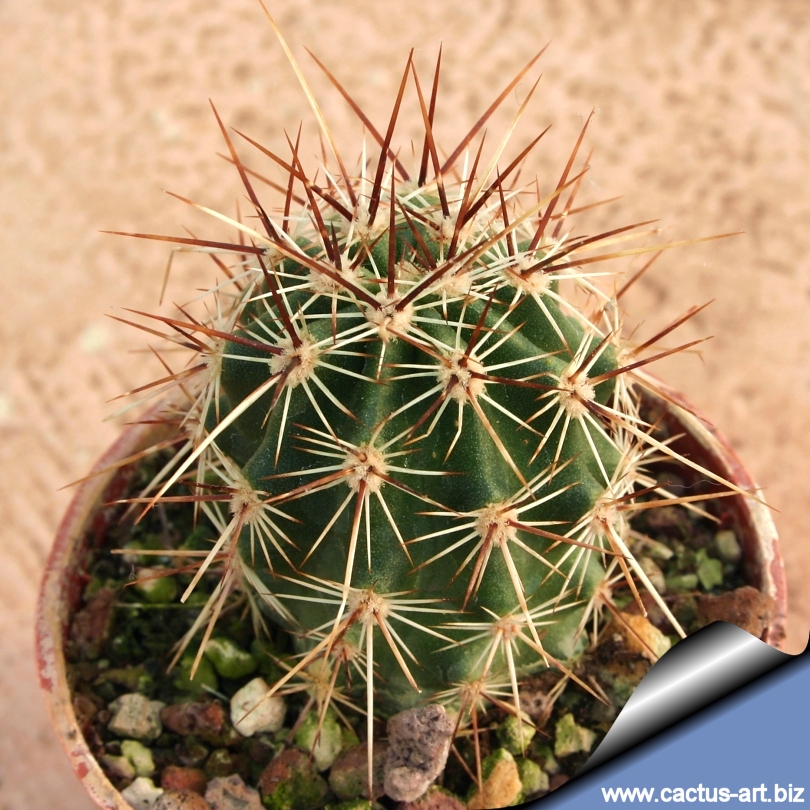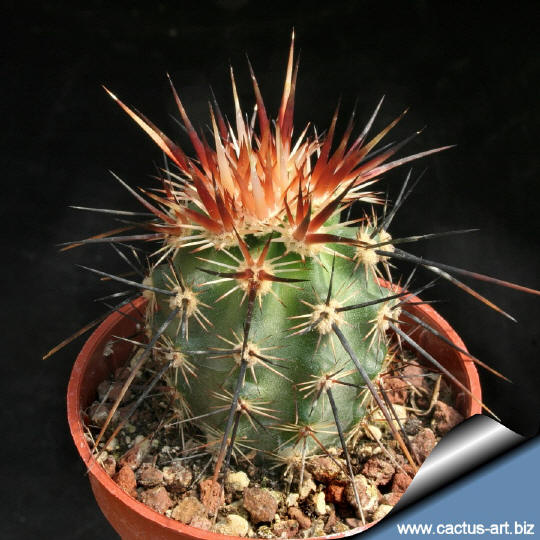|
|
|

Echinocereus chrysocentrus Indian springs.
This is one of the the most formidably spiny species within
the genus Echinocereus. It has browhnish/purple spines and bloom with
purple flowers. These plants are extremely exotic, yet they are very
cold hardy. |
|
Description: Formidably spined and free clumping columnar
cactus, 6-25-branched, ultimately forming somewhat open clumps of stems.
Stems: Suberect or erect light green, cylindric or somewhat
tapering distally, usually 15-20 cm tall, and about 5 cm in diameter,
branching freely from the base;
Ribs: 11 to 14 low obtuse, tubercles indistinct, crests slightly
undulate.
Areoles: 6-15 mm apart, wool present in first year only.
Spines: 8-20 per areole up to 13 cm long; divergent-porrect,
stout, and rigid, straight or curving and somewhat twisted,
brownish-purple (bright purple when young).
Radial spines: Lighter whitish to creamy coloured 8-20 mm long
long, spreading.
Flowers: From purple to lavender. The flowers are up to 7 cm in
diameter, 5-8 cm long . Flower tube hairy.
Blooming season: Spring, flowers are diurnal close at night and
reopen in the morning and last for about five days.
Fruit: Red or orangish 2.5-4cm long, spheric, fleshy, pulp
whitish be-coming infused with pink or red from the skin. The fruit is
edible, it is said to taste like strawberry.
|
|
Cultivation: In
cultivation the strawberry hedgehog grows rather slowly and it is
sensitive to overwatering (rot prone) needs a very good drainage to
avoid rotting, but requires more moisture than true desert cacti to
grow and produce flowers, Keep drier and cool in winter. Need full sun.
It is cold resistant to -10° ( or less depending on clones)
for short periods of time. It is a fine plant for a rock garden or
container, contrasts well with agaves, yuccas, and low-growing flowering
plants. It will show its flowers only if we provide
an adequate winter rest period.
Propagation: Seeds, also can be grown from cutting as it branches
from the base.
|
|


Advertising
|
|
|
|
|
Family:
Cactaceae (Cactus
Family)
Scientific name: Echinocereus
engelmannii (Parry ex Engelm.) Lem. var.
chrysocentrus (Engelm. & Bigelow) Engelmann ex
Rümpler 1885
in Engelmann 1856:283. [Fuller description in
Englemann 1857:35]
Origin: South-western USA
(Southern California, Arizona, southern Nevada, Utah) TL: Arizona, Bill
Williams River, J. M. Bigelow, 13 Feb. 1854 (MO).
Habitat: Grows on gravel, sand and rocky
hills.
Common Names include: Engelmann's hedgehog cactus,
Strawberry Hedgehog Cactus, Saint's cactus.
Conservation status: Listed in
CITES appendix 2.
Synonyms:
- Echinocereus chrysocentrus
(Engelmann & Bigelow) Orcutt 1926
- Echinocereus engelmannii (Parry
ex Engelmann) Lemaire.
Publisced in:
Cactées. 56. 1868
- Cereus engelmannii Parry ex
Engelmann
In: Amer. J. Sci. Arts, ser. 2, 14: 338. 1852
(as engelmanni);
|
|
|
|

Echinocereus (engelmanii) chrysocentrus (purpureus)
RP75 St. George, Washington County, Utah, USA
New spines in spring.
Photo of
conspecific taxa, varieties, forms and cultivars
of plants belonging to the
Echinocereus engelmanni
complex
(This
Taxon has lots of synonyms
whit several controversial varieties and subspecies and comprises a
multitude of different forms, but where each form is linked to others by
populations of plants with intermediate characteristics):
|
|